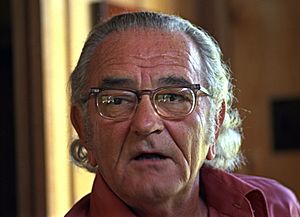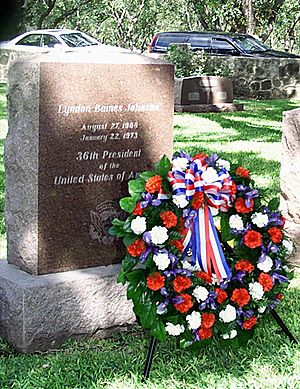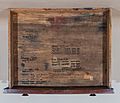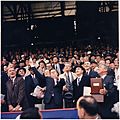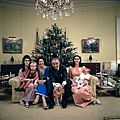Lyndon B. Johnson facts for kids
Quick facts for kids
Lyndon B. Johnson
|
|
|---|---|
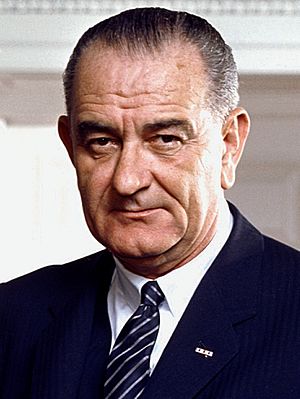
Johnson in 1964
|
|
| 36th President of the United States | |
| In office November 22, 1963 – January 20, 1969 |
|
| Vice President |
|
| Preceded by | John F. Kennedy |
| Succeeded by | Richard Nixon |
| 37th Vice President of the United States | |
| In office January 20, 1961 – November 22, 1963 |
|
| President | John F. Kennedy |
| Preceded by | Richard Nixon |
| Succeeded by | Hubert Humphrey |
| Senate Majority Leader | |
| In office January 3, 1955 – January 3, 1961 |
|
| Whip | Earle C. Clements Mike Mansfield |
| Preceded by | William F. Knowland |
| Succeeded by | Mike Mansfield |
| Senate Minority Leader | |
| In office January 3, 1953 – January 3, 1955 |
|
| Whip | Earle C. Clements |
| Preceded by | Styles Bridges |
| Succeeded by | William F. Knowland |
| Chair of the Senate Democratic Caucus | |
| In office January 3, 1953 – January 3, 1961 |
|
| Preceded by | Ernest McFarland |
| Succeeded by | Mike Mansfield |
| Senate Majority Whip | |
| In office January 3, 1951 – January 3, 1953 |
|
| Leader | Ernest McFarland |
| Preceded by | Francis J. Myers |
| Succeeded by | Leverett Saltonstall |
| United States Senator from Texas |
|
| In office January 3, 1949 – January 3, 1961 |
|
| Preceded by | W. Lee O'Daniel |
| Succeeded by | William A. Blakley |
| Member of the U.S. House of Representatives from Texas's 10th district |
|
| In office April 10, 1937 – January 3, 1949 |
|
| Preceded by | James P. Buchanan |
| Succeeded by | Homer Thornberry |
| Personal details | |
| Born |
Lyndon Baines Johnson
August 27, 1908 Gillespie County, Texas, U.S. |
| Died | January 22, 1973 (aged 64) Gillespie County, Texas, U.S. |
| Resting place | Johnson Family Cemetery |
| Political party | Democratic |
| Spouse | |
| Relations | Philip Bobbitt (nephew) |
| Children | |
| Parents |
|
| Education | |
| Occupation |
|
| Civilian awards | Presidential Medal of Freedom (posthumously, 1980) |
| Signature | |
| Military service | |
| Allegiance | United States |
| Branch/service | United States Navy |
| Years of service |
|
| Rank | |
| Battles/wars | |
| Military awards | Silver Star |
Lyndon Baines Johnson ( August 27, 1908 – January 22, 1973), often referred to by his initials LBJ, was the 36th president of the United States from 1963 to 1969. He became president after the assassination of John F. Kennedy. He also served as the 37th vice president from 1961 to 1963.
Johnson's administration passed many major laws that made substantial changes in civil rights, health care, welfare, and education. He was strongly criticized for his foreign policy, especially for American involvement in the Vietnam War.
Early life
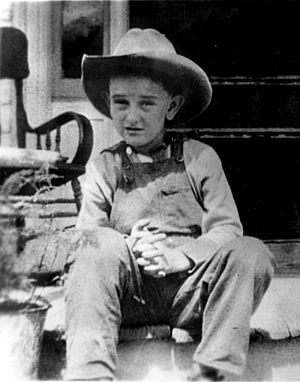
Lyndon Baines Johnson was born on August 27, 1908, near Stonewall, Texas, in a small farmhouse on the Pedernales River. He was the eldest of five children born to Samuel Ealy Johnson Jr. and Rebekah Baines. Johnson had one brother, Sam Houston Johnson, and three sisters, Rebekah, Josefa, and Lucia.
Johnson grew up poor, with his father losing a great deal of money. Biographer Robert Caro described him as being raised "in a land without electricity, where the soil was so rocky that it was hard to earn a living from it."
Education
Johnson graduated in 1924 from Johnson City High School. In 1926, he enrolled at SWTSTC. The college years refined his skills of persuasion and political organization. For nine months, from 1928 to 1929, Johnson paused his studies to teach Mexican–American children at the segregated Welhausen School in Cotulla, 90 miles (140 km) south of San Antonio. The job helped him to save money to complete his education, and he graduated in 1930 with a Bachelor of Science in history and his certificate of qualification as a high school teacher. He briefly taught at Pearsall High School in Pearsall before taking a position teaching public speaking at Sam Houston High School in Houston.
When he returned to San Marcos in 1965, after signing the Higher Education Act of 1965, Johnson reminisced:
I shall never forget the faces of the boys and the girls in that little Welhausen Mexican School, and I remember even yet the pain of realizing and knowing then that college was closed to practically every one of those children because they were too poor. And I think it was then that I made up my mind that this nation could never rest while the door to knowledge remained closed to any American.
Active military duty (1941–1942)

Johnson was called to active duty three days after the Japanese attack on Pearl Harbor in December 1941. He received the Silver Star for gallantry in action.
He was also awarded the American Campaign Medal, Asiatic-Pacific Campaign Medal, and the World War II Victory Medal.
Political career
Johnson won election to the U.S. House of Representatives in 1937. In 1948, he became a senator, rising to the positon of the Senate Democratic leader in 1953 and majority leader in 1954. In 1960, Johnson ran for presidency. Ultimately, Senator Kennedy made Johnson his vice presidential running mate. The Kennedy–Johnson ticket won the general election. Vice President Johnson assumed the presidency in 1963, after President Kennedy was assassinated.
Presidency (1963–1969)
Johnson was sworn in as the nation's 36th president aboard Air Force One at Dallas Love Field two hours and eight minutes after Kennedy's assassination.
During his tenure, Johnson sought to expand civil rights, public broadcasting, access to health care, aid to education and the arts, urban and rural development, and public services. He aimed to create better living conditions for low-income Americans by spearheading the war on poverty. As part of these efforts, Johnson signed the Social Security Amendments of 1965, which resulted in the creation of Medicare and Medicaid.
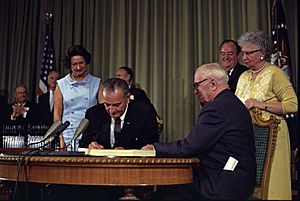
During the Johnson administration, national poverty declined significantly, with the percentage of Americans living below the poverty line dropping from 23 to 12 percent.
Johnson made the Apollo program a national priority; enacted the Higher Education Act of 1965, which established federally insured student loans; and signed the Immigration and Nationality Act of 1965, which laid the groundwork for U.S. immigration policy today. His civil rights legacy was shaped by the Civil Rights Act of 1964, the Voting Rights Act of 1965, and the Civil Rights Act of 1968. His foreign policy prioritized containment of communism, including in the ongoing Vietnam War. He launched a full-scale military intervention in Southeast Asia, dramatically increasing the number of American military personnel deployed; casualties soared among U.S. soldiers and Vietnam civilians. In 1968, the communist Tet Offensive inflamed the anti-war movement and public opinion turned against America's involvement in the war.
Johnson began his presidency with near-universal support, but his approval declined throughout his presidency as the public became frustrated with both the Vietnam War and domestic unrest. Johnson initially sought to run for re-election; however, following disappointing results in the New Hampshire primary he withdrew his candidacy.
Space program
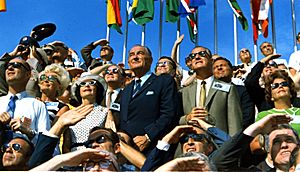
During the Johnson administration, NASA conducted the Gemini crewed space program, developed the Saturn V rocket and its launch facility, and prepared to make the first crewed Apollo program flights. On January 27, 1967, the nation was stunned when the entire crew of Apollo 1 was killed in a cabin fire during a spacecraft test on the launch pad, stopping Apollo in its tracks. Rather than appointing another Warren-style commission, Johnson accepted Administrator James E. Webb's request for NASA to do its own investigation.
Johnson maintained his staunch support of Apollo through Congressional and press controversy, and the program recovered. The first two crewed missions, Apollo 7 and the first crewed flight to the Moon, Apollo 8, were completed by the end of Johnson's term. He congratulated the Apollo 8 crew, saying, "You've taken ... all of us, all over the world, into a new era." On July 16, 1969, Johnson attended the launch of the first Moon landing mission Apollo 11, becoming the first former or incumbent U.S. president to witness a rocket launch.
Vietnam War
At Kennedy's death, there were 16,000 American military personnel in Vietnam supporting South Vietnam in the war against North Vietnam. Vietnam had been partitioned at the 1954 Geneva Conference, with North Vietnam led by a Communist government. Johnson subscribed to the Domino Theory and to a containment policy that required America to make a serious effort to stop all Communist expansion. On taking office, Johnson immediately reversed Kennedy's order to withdraw 1,000 military personnel by the end of 1963. In late summer 1964, Johnson seriously questioned the value of staying in Vietnam but, after meeting with Secretary of State Dean Rusk and Chairman of the Joint Chiefs of Staff Maxwell D. Taylor, declared his readiness "to do more when we had a base" or when Saigon was politically more stable. He expanded the numbers and roles of the American military following the Gulf of Tonkin Incident.
In what was termed the October surprise, Johnson announced to the nation on October 31, 1968, that he had ordered a complete cessation of "all air, naval and artillery bombardment of North Vietnam", effective November 1, should the Hanoi Government be willing to negotiate and citing progress with the Paris peace talks. A week later, on November 5, Republican candidate Richard Nixon won the 1968 presidential election.
Post-presidency (1969–1973)
After leaving the presidency in January 1969, Johnson went home to his ranch in Stonewall, Texas, accompanied by former aide and speechwriter Harry J. Middleton, who would draft Johnson's first book, The Choices We Face, and work with him on his memoirs, The Vantage Point: Perspectives of the Presidency 1963–1969, published in 1971. That year, the Lyndon Baines Johnson Library and Museum opened on the campus of The University of Texas at Austin. He donated his Texas ranch in his will to the public to form the Lyndon B. Johnson National Historical Park, with the provision that it "remain a working ranch and not become a sterile relic of the past".
Death and funeral
Johnson died on January 22, 1973 from a heart attack.
Johnson was honored with a state funeral. He was buried in his family's private cemetery at the house in which he was born.
Memorials
The Manned Spacecraft Center in Houston was renamed the Lyndon B. Johnson Space Center in 1973, and the United States Department of Education headquarters was named after Johnson in 2007. The Lyndon B. Johnson School of Public Affairs at the University of Texas at Austin was named in his honor, as is the Lyndon B. Johnson National Grassland. Also named for him are schools in Austin and Laredo, Texas; Melbourne, Florida; and Jackson, Kentucky. Interstate 635 in Dallas is named the Lyndon B. Johnson Freeway. The Lyndon Baines Johnson Memorial Grove on the Potomac was dedicated in 1976.
Johnson was awarded the Presidential Medal of Freedom posthumously in 1980. Texas created a state holiday on August 27 to mark Johnson's birthday, known as Lyndon Baines Johnson Day.
Major legislation signed
- 1963: Clean Air Act
- 1963: Higher Education Facilities Act
- 1963: Vocational Education Act
- 1964: Civil Rights Act
- 1964: Urban Mass Transportation Act
- 1964: Wilderness Act
- 1964: Nurse Training Act
- 1964: Food Stamp Act
- 1964: Economic Opportunity Act
- 1964: Housing Act
- 1965: Higher Education Act
- 1965: Older Americans Act
- 1965: Coinage Act
- 1965: Social Security Act
- 1965: Voting Rights Act
- 1965: Immigration and Nationality Services Act
- 1966: Animal Welfare Act
- 1966: Freedom of Information Act
- 1967: Age Discrimination in Employment Act
- 1967: Public Broadcasting Act
- 1968: Architectural Barriers Act
- 1968: Bilingual Education Act
- 1968: Civil Rights Act
- 1968: Gun Control Act
Significant regulatory changes
Works
- National Aeronautics and Space Act (1962)
- Choices We Face (1969)
- The Vantage Point (1971)
Images for kids
-
Johnson's boyhood home in Johnson City, Texas
-
Opening Day of the 1961 baseball season. President Kennedy throws out the first ball at Griffith Stadium, the home field of the Washington Senators, as LBJ and Hubert Humphrey look on.
-
Vice President Johnson visiting Finland in September 1963; here seen with Mrs. Johnson, while Urho Kekkonen, the President of Finland, welcomes them.
-
LBJ is sworn in on Air Force One by Judge Sarah Hughes as Mrs. Johnson and Mrs. Kennedy look on.
-
Meeting with civil rights leaders Martin Luther King Jr. (left), Whitney Young, and James Farmer in the Oval Office in 1964
-
President Lyndon B. Johnson, Martin Luther King Jr., and Rosa Parks at the signing of the Voting Rights Act on August 6, 1965
-
Former president Truman and wife Bess at Medicare Bill signing in 1965, as Lady Bird and Hubert Humphrey look on
-
Former President Lyndon B. Johnson (center left) and Vice President Spiro Agnew (center right) witness the liftoff of Apollo 11.
-
Lady Bird Johnson and LBJ with Ferdinand and Imelda Marcos on September 12, 1966
-
Shah of Iran Mohammad Reza Pahlavi and Queen Farah Pahlavi with the Johnsons on their visit to the United States
-
Secretary of Defense Robert McNamara and General Westmoreland in Vietnam 1965
-
Johnson talking with his Secretary of Defense Robert McNamara, 1967
-
Vietnam War protestors march at the Pentagon in Washington, D.C. on October 21, 1967. Support for the war was dropping and the anti-Vietnam War movement strengthened.
-
Walt Whitman Rostow shows President Lyndon B. Johnson a model of the Khe Sanh area in February 1968
-
Soviet Premier Alexei Kosygin (left) next to Johnson during the Glassboro Summit Conference
-
President Johnson meets with Republican candidate Richard Nixon in the White House, July 1968.
-
Johnson in the Oval Office in 1969, a few days before Richard Nixon's inauguration
-
With the appointment of Thurgood Marshall, Johnson placed the first African American on the Supreme Court.
-
Johnson lying in state in the United States Capitol rotunda
-
Johnson's image as it appears in the National Portrait Gallery in Washington, D.C.
-
Front view of the Lyndon Baines Johnson Library and Museum located on the campus of the University of Texas in Austin, Texas
See also
 In Spanish: Lyndon B. Johnson para niños
In Spanish: Lyndon B. Johnson para niños


